Once you master the basic flies, move on the the special situations.
Emerger
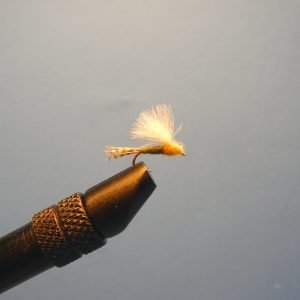
Why You Care: The emerger represents the lifecycle of an insect when it attempts to break out of the nymphal shuck and become an adult fly. When mature, nymphs swim to the surface and stay in the surface film while they transition. During a hatch, trout target emergers since they may struggle visibly for many minutes, attracting attention, before being able to fly away. Many never make the transition and become cripples (another class of fly).
Description: These flies look like nymphs with a small sack on top or a cut down dry fly. The small sack mimics the unfolding wings present during the transition and provides a small amount of flotation to keep the fly in the surface film. The “dry fly” version (first picture) features smaller hackle to keep the fly from floating on top of the water
Typical Use: Fish at or just below the surface. Use floatant to manage the depth; a small amount goes a long way, and the emerger will sink lower as the floatant dissipates. Since these flies sit just below the surface of the water, they are tough to see making it easy to miss a hit. Therefore, tie the emerger as a dropper to a dry fly; allowing the dry to act as the strike indicator. Cast up and across the stream and manage the line to achieve a drag free drift.
Midge
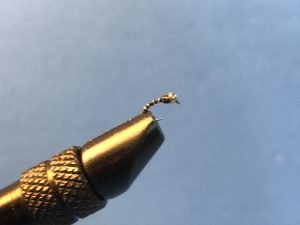
Why You Care: Since trout spend most of their time feeding below the surface, it is important to mimic all the food they could be presented. A midge is another type of nymph. In fact, since midges represent about ½ of the available food supply, those anglers who do not have a midge or two in their fly box will be sorely disappointed and skunked more often than not.
Description: Midges are small nymphs. Really, really, really small nymphs. They usually come in sizes 18, 20, and 22 with a tiny hook eye that is almost impossible to thread tippet through. True fly fishing masochists even use size 26! Good luck getting that tied on.
Typical Use: Like other nymphs, fish them deep. If they are not bouncing off the bottom, they are too high in the water column. The easiest way to fish them is as a dropper on a regular nymph.
Egg
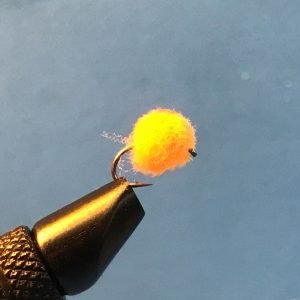
Why You Care: In the fall when trout spawn, eggs are in the food chain. When present, trout gleefully snap them up.
Description: Not especially difficult to recognize, egg patterns look like small eggs and can be made from yarn. Yep. Think those salmon eggs you pulled out of the bait jar… Another variation is a small bead tied into the tippet above the hook.
Typical Use: Since trout lay eggs on the bottom of the stream, these flies must be fished deep. Accordingly, you can expect to lose a few when they get hung up. Only use an egg pattern on a body of water that experiences migration of larger fish who would produce eggs matching the size of these flies. These will not work on a small brookie stream where small fish produce tiny eggs. Even more so than other patterns, the egg must be fished naturally. Since the real ones are so light, any drag at all will tell the fish your fly is a fake.
Worm
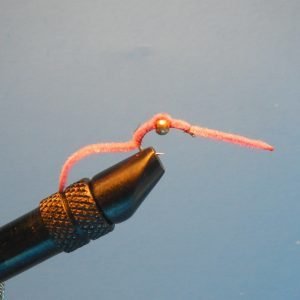
Why You Care: Simply put, all fish like worms!
Description: Typically called the “San Juan Worm” or “Squirmy Wormy.” The difference between the two is the squirmy wormy is usually a soft plastic worm imitation while the San Juan is made from stiffer fiber such as Chenille or Pearl Core Braid. Regardless of material, stick with the ones tied on a curved hook since the experts believe the curve makes the worm look more natural.
Typical Use: Although you can fish a worm anytime, it is most effective after a rain when real worms are likely to wash into the stream. Use them under an indicator (just like a nymph) with small amount of weight to keep their movement natural. If there is no hatch, fish a worm!
Popper
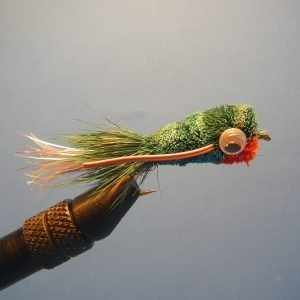
Why You Care: The popper is to bass or bream as a dry fly is to trout.
Description: Poppers come in all sizes and shapes with the consist feature being a large round floating body with feathers, rubber legs or large hackle at the rear. The front of the popper can be round, tapers or conical. Each shape results in a different type of attractive disturbance when stripped (aka popped).
Typical Use: Cast as you normally would. Allow the popper to make contact with the surface and STOP! Do not start stripping right away. Instead, wait until the splash rings have died down and then give a short pop. The cone front poppers will make a popping noise/splash while the other have less noise. After popping, wait a bit before you pop it again.
